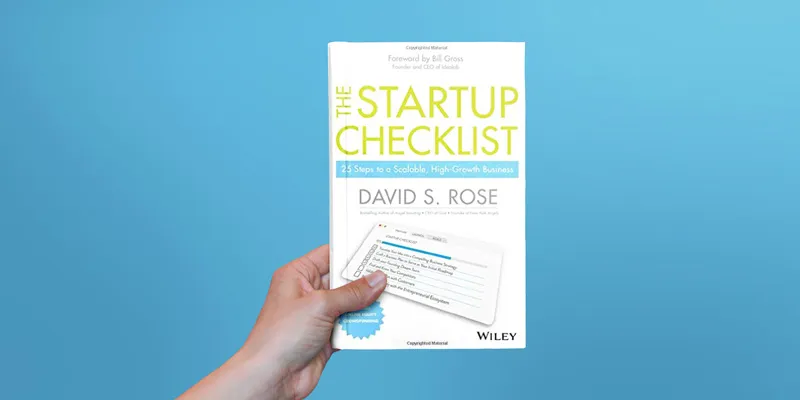The Startup Checklist: 25 steps to a scalable high-growth business
The informative book, ‘The Startup Checklist’ offers 25 actionable steps for entrepreneurs to take their initial concepts to business scale, mapped onto three clear phases.

“Being an entrepreneur is one of the greatest ways to make the world a better place,” begins Bill Gross, Founder of Idealab, in the Foreword. “There are a thousand things you can do to unwittingly undermine success,” he adds – hence the usefulness of this book for entrepreneurs as a checklist of do’s and dont’s.
David S. Rose is the author of Angel Investing (see my book review), CEO of Gust, and Founder of New York Angels. He is a serial entrepreneur and has invested in over 100 companies.
David offers this book as a comprehensive guide to entrepreneurs once they have a creative idea and startup intention in place (for these earlier phases, see my reviews of the books $100 Startup, Little Bets, and Trend-Driven Innovation). He classifies typical mistakes founders make into four types – fundamental (eg. unneeded product), painful (eg. wrong team), tragic (eg. bungled equity allocation) and expensive (eg. legal, accounting).
Here are my takeaways from this 306-page book, summarised in Table 1 and in the points below. The appendix has useful resources (also accessible online) such as a due diligence request, corporation registration checklist, founder accord template, and sample term sheets.
Table 1: Phases, Steps and Tools for Startups
I. Preparation for launch
David offers a list of useful books as starting resources (see also my pick of ‘Top 10 Books for Entrepreneurs’ for 2016, 2015, 2014, 2013, 2012). Founders should develop not just a product or service concept but also a business concept, plotted in the business model canvas. Scalable and high growth businesses attract investors if they are in a product or service category where the number of purchasers, market share, sale revenue, profit margins and competitive moat are attractive enough.
It is a misconception that business plans are no longer needed, but a lean business plan is more apt at this stage than a full-fledged business plan (see Tim Berry’s online tools). The lean business plan connects strategy, tactics (marketing, product) and concrete specifics (assumptions, schedule, milestones, metrics) in a three-layer pyramid. This forms the basis of the ‘plan, run, review, revise’ cycle.
Many founders erroneously assume that they have no competition, or that potential competitors are too far behind. Competitors should be mapped and assessed via their websites, marketing collaterals, online reviews, industry appearances, social media presence, and even employees. Competitive grids, quadrant charts and petal charts are useful visualisations in this regard.
The ‘dream team’ should have a mix of core creative partner and business-oriented partner. The key entrepreneur quality is one of vision, passion and risk-taking, and can reside in people with diverse backgrounds – tech, sales, design, or finance.
"Starting a business is one of the most emotionally draining activities you can possibly engage in, right up there with marriage and parenting,” explains David. Founders should develop a clear understanding of their roles, time allotments, financial contributions, and expectations of ownership, risk and control.
Frank Demmler’s tool, the Founders’ Pie Calculator, offers a useful way to allot equity to the founders based on their ideas, expertise, commitment, risk and responsibilities. Equity is allotted via shares, shareholder agreements and the board of directors. Equity should be allocated in larger portion to those who add real unique value rather than to those whose services can be purchased on the market for cash.
The MVP can be a working prototype, mockup, demo, video demo, or a service simulation (see my reviews of the books Lean Startup and Disciplined Entrepreneurship). Results of testing can be reformulation of the original concept or pivot of product and business model. Customers will eventually buy the product or service if they find it valuable (useful, attractive, desirable).
Startups should promote their site through social media and related sites as well, such as Quora, Crunchbase, LinkedIn, Glassdoor, AngelList and Gust. Crowdfunding sites also offer ways of validation, eg. KickStarter, Indiegogo.
“Embracing the ecosystem will pay off in the long run more than you realise,” David advises, urging founders to network extensively. “It is precisely because the startup game is so personal and lonely that you must take it upon yourself to reach out and connect with the rest of us who are pursuing parallel paths,” he adds. Founders should take part in meetups, business plan competitions, startup conferences, demo events, angel groups and other peer programs.

II. Launch and build the company
Founders need to develop a deep, intuitive understanding of business finance, as well as the use of analytics to understand their business and pitch it to investors. They must create a positive, productive culture which retains the sense of creative ferment and excitement even as the company grows.
In the US, registration in Delaware as a C Corporation is a common option (social enterprises would choose B Corporation). Benefits include limiting liabilities and shared ownership. Lawyers are important at early stages as well to sort out issues of registration, bylaws, agreements, filings, employment and IP. Boards of advisors and directors contribute significantly through their ‘wealth, work and wisdom’ (see my review of the book Startup Boards).
Accounting and bookkeeping functions help founders track balance sheets, cash flows and budgets. Founders should set up business banking and credit accounts, get a DUNS number from Dun&Bradstreet, and track their credit ratings via agencies like Experian, Equifax and TransUnion. Digital transactions can be facilitated by payment processors such as BrainTree (owned by PayPal), Stripe and Square.
In addition to cloud hosting, other useful online tools are available for conducting surveys (Google Forms, SurveyGizmo, Zommerang), CRM (Zoho, SalesForce, SugarCRM), customer support (FreshDesk, ZenDesk), HR (Zenefits, JustWorks, WorkDay), team communications (Slack, Yammer, Sococo), project management (Trello, Asana, BaseCamp), marketing (MailChimp, HubSpot, SendGrid) and social media management (HootSuite, SocialFlow, Sprout Social).
A/B testing and cohort analysis help in refining the MVP, by monitoring metrics such as rates for clickthroughs, sign-up, trial membership, annual membership, conversion and lifetime value. Net Promoter Scores segment the user base into promoters, passives and detractors.
“Entrepreneurs are an optimistic lot, and self-delusion is fundamental to our psychological makeup,” David cautions; hence the need for metrics which are actionable, accessible and auditable. These metrics should help assess product pricing, channel effectiveness, traction, and customer decision processes.
Useful insights on hiring are offered by Lex Sisney, author of Organisational Physics. In growth stage, startups tend to over-hire. However, design skills seem to be in shortage across the startup world. Employees can be classified into starters, stars, team players, team leaders, and specialists. These categories and levels of compensation depend on the employee demands, expectations, qualifications, personalities and attitudes.
“For a company to survive and thrive, its culture needs to be authentic, universal and consistent,” David explains. The core team may work well beyond accepted notions of ‘work-life balance,’ but then they enjoy being in such a challenging environment.

III. Fundraising, investor collaboration and exit
Founders aiming for scaleable business growth may need to turn to institutional sources of funding in different stages. Cut-off points are roughly in the range of $25K (personal funds), $150K (friends and family), $1.5M (angels), $10M (early stage VCs) and $20M (late stage VCs).
Investors should be chosen for their ‘smart money,’ commitment, network of other investors, and personal chemistry with the founder. Founders should understand what investors are looking for: strong management team, business opportunity, ‘painkiller’ product, stage of the business, and business plan quality.
Investors are reactive rather than proactive, so founders should cultivate an active investor pipeline. The pitch deck and documents should be of varying length and depth (see my related article, ‘How to make a great startup pitch’).
A number of online funding platforms have been launched by investor groups and angels. Crowdfunding accounts for hundreds of millions of dollars but is still in its infancy, with more regulatory maturity needed. The author also provides useful checklists of the different types of equity investments, diligence, and term sheets.
The content, nature and timing of communication with the founder and investor is critical, and shapes future funding rounds. Valuation methods include scorecard valuation and risk factor summation. Emerging methods are based on big data analytics, and this will be a space to watch.
In the long run, the founder can continue with his startup, sell it to a larger company, take the company public, or shut it down – and then start all over again!








